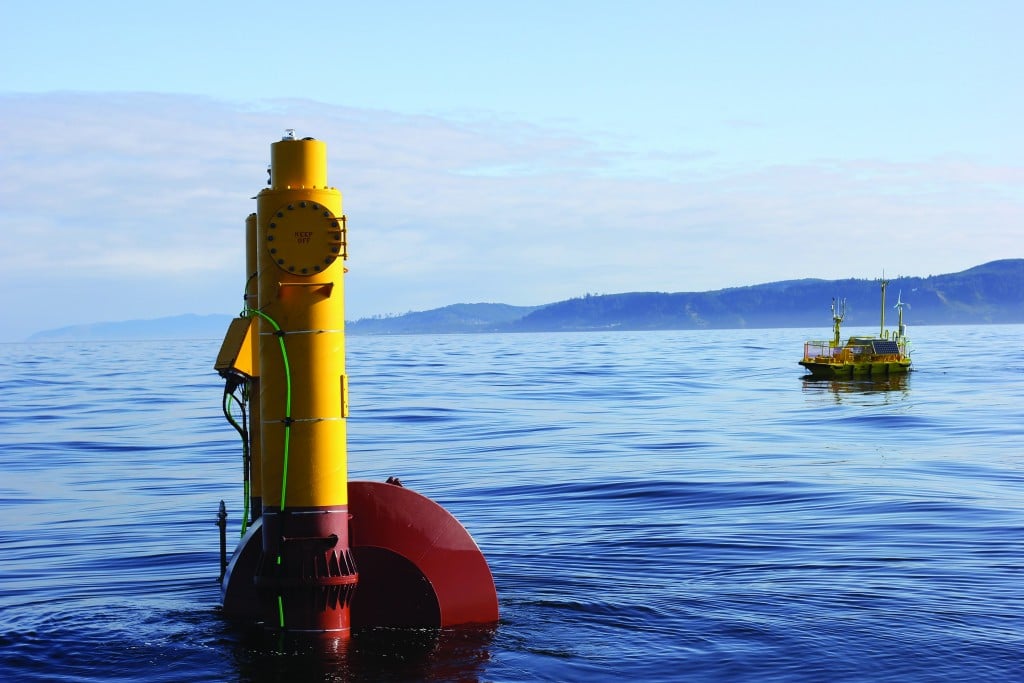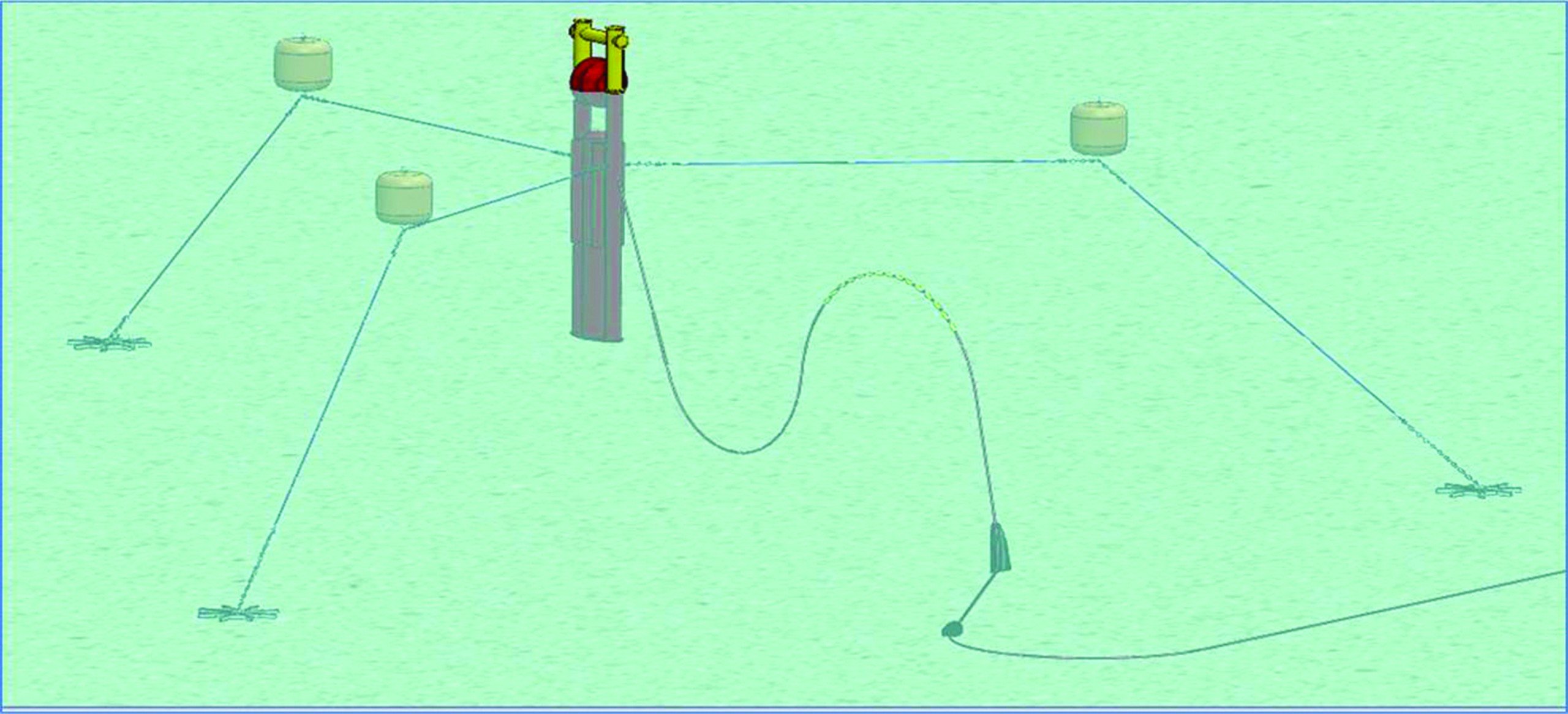The Navy and private companies collaborate to turn wave energy into electricity

Photography Courtesy of Northwest Energy Innovation
Devices to measure wave energy and convert it into electricity will be deployed in Kaneohe Bay near Marine Corps Base Hawaii starting this year, say the Navy, state Rep. Cynthia Thielen and a private company. The eventual goal is to develop a full-scale source of electricity that can be added to Oahu’s grid.
The wave-energy conversion device, called Azura, was developed by Northwest Energy Innovations, a company based in Portland. The 50-foot-high device will bob on the surface while anchored to the bottom in 100 feet of water, about three-fifths of a mile offshore.
The plan is to run tests for up to a year, with the hope of eventually going into commercial operation, Thielen says. Such devices could plug into Oahu’s grid, but also serve as prototypes to supply energy to areas throughout the Pacific, according to the Oregon company.
Two more devices called Wave Energy Technology-New Zealand or WET-NZ – each more advanced than the first test device – will be deployed later, sometime after 2015, in deeper parts of Kaneohe Bay. These types of energy converters, first developed in New Zealand, maximize the amount of energy captured because they use all of a wave’s motions: heave, surge and pitch. Heave is the up-and-down motion of waves, surge is front-and-back motion, and pitch or sway is side-to-side motion.
“The wave energy test site (WETS) is a Navy-funded project that supports the research and development of renewable energy sources by providing a location off Marine Corps Base Hawaii to test wave energy conversion devices,” explains Alexandra DeVisser, WETS project manager for the U.S. Navy, in an email.
“In addition to the 30-meter test berth, WETS infrastructure will include two new, deep-water berths to be installed in the fall,” says DeVisser. “The two new test berths will each contain three mooring legs into which each wave-energy conversion (WEC) device will attach, undersea power and data communications to shore, and connections to on-shore electrical equipment.”
Thielen says the deeper berths will be in water that is about 200 feet and 300 feet deep, off MCBH. DeVisser says they will be a little more than a mile offshore.
DeVisser says developing a wave-energy industry will take time. “Wave-energy conversion technology is in the early stages of development, so it will be a few years before these types of devices are designed and built specifically for full-commercial scale operations,” she says.
However, she adds, “It is the goal of all ocean-wave energy developers to convert ocean-wave energy into useable electric power for utility or grid-scale applications. Wherever isolated grids, remote locations, high costs of energy, and energy security are of importance, wave-energy conversion may become another distributed generation option for diversifying the energy system.”
Steven Kopf, founder and CEO of Northwest Energy Innovations, points out in an email that the goal of the test device in Kaneohe Bay is “to validate our computer simulations.”
“The test data that will be obtained from this test,” Kopf adds, “is a critical step in developing a full-scale commercial machine.”

The diagram shows how a wave energy conversion device that floats partly on the surface is anchored to the ocean floor, and held in position with buoys. A cable carries generated electricity to shore. Rendering: Courtesy of Northwest Energy Innovations
DeVisser says all project-related buoys and devices will be equipped with U.S. Coast Guard-approved warning lights and signage. The public will be prohibited from tying up to or boarding any of the devices or buoys.
The U.S. Department of Energy is also playing a role in testing wave-energy devices in Hawaii and during the next two years will provide $10 million in grant funding. The Department of Energy website notes that the grant will help “test prototypes designed to generate clean, renewable electricity from ocean waves and help diversify America’s energy portfolio.”
“This is extremely exciting,” says Thielen, a longtime advocate of wave energy. “Hawaii, on average, has the highest recorded wave power in the world. Wave power is different from surfer waves, totally different. It’s the surge, the movement of the ocean. It can take place up to a mile or more offshore.
“Because we have forecasts from NOAA (the National Oceanic and Atmospheric Administration) 24 to 48 hours in advance,” Thielen says, “we can forecast what the wave-energy climate could be. Maybe 8 percent of the time, when the wave climate is not as powerful, HECO would have that data and be able to make an adjustment.”
That means wave energy is a form of reliable or firm power – like burning oil – and not a variable energy source, such as solar or wind power.
Countries as varied as Australia, Ireland, Britain, Portugal and Spain are already using wave energy in some form, Thielen says, and their use and experiments have helped move the technology forward.
Thielen believes the testing in Kaneohe Bay provides the opportunity to move wave energy in Hawaii from testing to commercial use.
“This is better than fossil fuel,” Thielen says. In some areas of the world, she says, the cost in cents per kilowatt hour of wave energy is “single digits.” Compare that to the cost of electricity in Hawaii, where “we pay over 30 cents per kilowatt hour,” she says.
The military has supported wave-energy tests in Hawaii before. In 2010, a power-generating buoy developed by Ocean Power Technologies was installed off the Marine base. Under optimal conditions, the yellow bobbing buoy – a small generator – created enough electricity to power 20 to 25 homes.
At that time, Brian Cable, a mechanical engineer and project manager for the Naval Facilities Engineering Command’s Wave Energy Technology project, said in a statement quoted on the Department of Energy website: “We’re really trying to help the Navy meet its energy goals, which are to reduce dependence on fossil fuels. The Navy’s goal is to utilize half of our total energy consumption, ashore and afloat, from alternate energy sources by 2020.”
Cable also noted: “The main goal is to power onshore military installations like MCBH, and the larger onshore power grid. The other potential application would be to power autonomous systems with smaller power needs, such as scientific data collection points in the middle of the ocean.”






